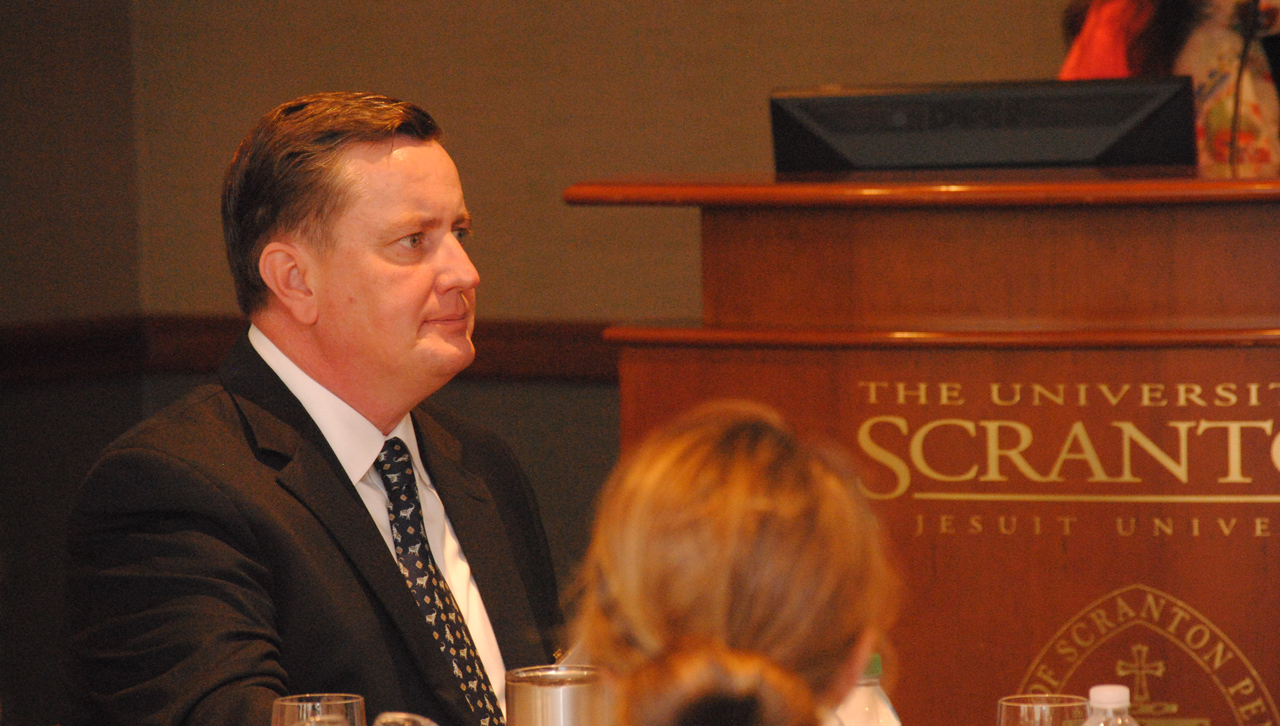Infectious Disease Expert Discusses Outbreaks, Responses and Covid-19

As the keynote speaker for the April 30 President’s Business Council webinar, Col. James Cummings, M.D. ’88, H’15, president of ICON Government and Public Health Solutions, Inc., discussed everything from the history of pandemics to possible vaccines.
Following his graduation from Georgetown University School of Medicine, Cummings spent 26 years in the U.S. Army. He has maintained a close connection with The University of Scranton as a member of the University’s Medical Alumni Council (MAC) and mentor to pre-medical students. Prior to his current position at ICON, he was vice president of clinical development and translational medicine at Novavax, a clinical-state biotechnology company “committed to delivering novel products to prevent a broad range of infectious diseases.”
Prior to Novavax, he was director at the Department of Defense’s Global Emerging Infection Surveillance and Response Systems (DoD-GEIS) responsible for oversight, development, functionality and fiscal accountability of the DoD’s global surveillance program for emerging infectious disease.
Here are some highlights from his talk, which you can watch in its entirety, here.
On Pre-COVID
“We’ve done a lot of learning through all of these outbreaks. And we do a lot of continued planning and learning even when there’s not an outbreak occurring. Across the whole of government, and not just the U.S. government, but other governments as well, NGOs, academic institutions, commercial biopharmaceutical companies, CROs, like the one I run at Icon, and others. We get together very regularly to discuss and learn from what we call Disease X, that’s the next pathogen, generally considered to be a viral pathogen, that will be infecting humanity and could be responsible for an outbreak or a pandemic.”
On Who it Affects
“I can tell you from the death rate…it’s not only the elderly or those who are medically compromised who are ill in the hospital, on ventilators or who are dead. This certainly has a concentration in elderly or medically compromised, but it crosses the spectrum of humanity in terms of who it’s affecting directly.”
On Biosurveillance
“There’s a national strategy for biosurveillance that’s been in place for many years. When you see a constellation of people becoming ill and you don’t know why they’re becoming ill, we’re very fortunate now that we have gene sequencing available and we can detect novel infectious agents just like this coronavirus. And that was done in China. We take that data, we review it, we integrate it, we analyze it. We turn it into actionable information that you can disseminate to key leaders and to people who can make a difference in what that information might mean. That decision gives support and feedback about where next to go for biosurveillance.”
On Healthcare Innovations
“There are DNA-based vaccines and mRNA-based vaccines. These vaccines involve injections either intramuscularly or subdermally, and then, generally speaking, some electroporation, just a fancy name for a little bit of electrical stimulus on the skin to drive that DNA or mRNA into our dendritic cells and get a robust immune response.”
“There are more traditional vaccine production methodologies either protein subunit vaccines, replicating viral vector vaccines, and virus-like particles, nonreplicating viral vectors and live attenuated virus. The inactivated, think of that like your traditional flu vaccine where we grow a bunch of virus, we kill it, then we give your immune system a little taste of that virus. Your immune system develops a robust response to that and realizes that’s the wanted poster for your immune system. The majority of these are all, for the most part, acting against the glycoprotein spike on the coronavirus.”
“There is good news on the horizon, because these platforms have already been developed for other coronaviruses. The good news is that they were able to turn the key on the machine and go very quickly with a safe product into phase one testing.”
On Cooperation
“In my short career, 26 years or so, there’s been a great development or maturation, I think, of relationships with the FDA and other regulatory agencies and industry. There are partnerships for developing solutions moving forward. Where, at one point in time, the FDA may not have been looked at as a facilitator of great products, but more of a policeman, now what’s happening is that the FDA is really bringing to bear the full might of their knowledge and their power as a regulatory agency…to ensure that we’re very rapidly assessing these investigational new drugs or vaccines or diagnostics and facilitating great work moving forward faster.”
“The regulatory process has really sped up in terms of total amount of time it requires to ensure a safe product is moving forward. That is key. You don’t want a rubber stamp, and that’s not what they’re giving. They are giving a very thoughtful review in a more expedited fashion.”
“No one’s looking for shortcuts.”
On Opening
“It’s a very fluid situation. This isn’t a light switch that we flip on and say ‘OK we’re open for business now.’ This is going to be a very segmented transition. And when you say, ‘getting back to normal,’ it’s a new normal.”
“I’m a fan of the build, measure, learn cycle. So, we’ll take a look, we’ll make a data-driven decision, then we will monitor to see what that decision produced.”
“In educators’ standpoints, there’s so much value in having people together. …You really want kids to have that socialization and that process of further maturation and development, but it can’t be at the cost of endangering their health. So I think we have to be very practical and pragmatic.”






